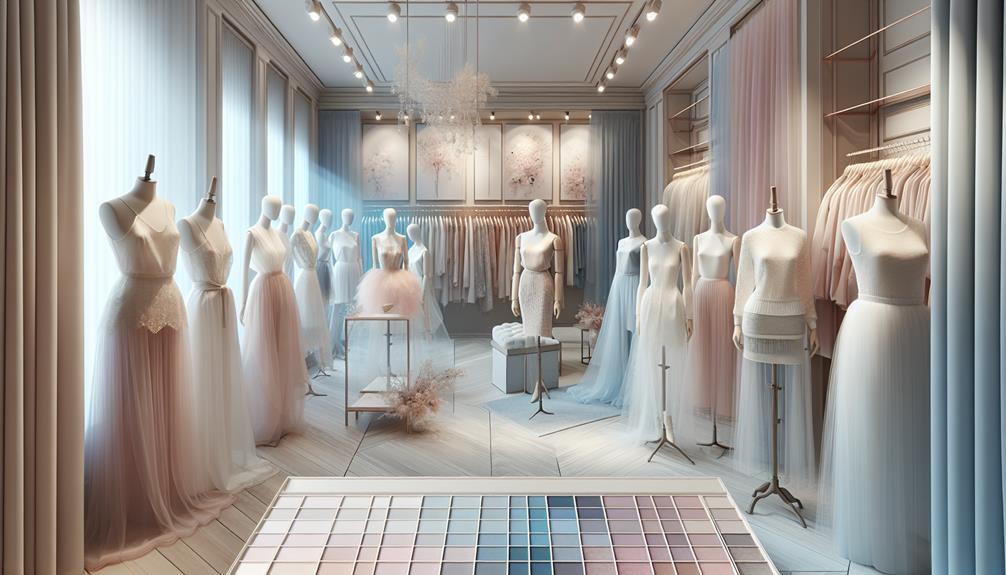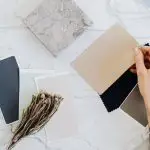I've found that georgette, organza, and voile are quite similar to chiffon. Georgette, which is a bit heavier and has a crinkly texture, still pulls off that light, flowy feel you get with chiffon. Organza steps up with a stiffer structure, giving it a sheer yet sculpted look that's surprisingly durable. Voile offers a gentle drape and is super breathable, making it perfect for both clothing and decor. They're all great for creating elegant, breathable garments that feel soft and luxurious. Curious about more fabrics like these? There's a whole lineup of options that could catch your fancy.
Table of Contents
Key Takeaways
- Georgette fabric is similar to chiffon with a crinkly surface and slightly heavier weight.
- Organza fabric offers a sheer, delicate appearance with a stiff structure that holds shape.
- Voile fabric is breathable and provides a gentle drape, suitable for clothing and curtains.
- Silk Crepe fabric features a crinkled surface with a matte finish and light, breathable qualities.
- All these fabrics share characteristics like breathability, versatility, color retention, softness, and low elasticity.
Exploring Georgette Fabric
While chiffon is well-known, let's dive into its lesser-known cousin, georgette fabric, which shares some similarities but has unique characteristics of its own. Originating from early 20th century France, georgette is named after the dressmaker Georgette de la Plante. I find its crinkly surface quite fascinating, which is a result of the highly twisted yarns used in its weaving. This twist creates the slight puckers that give georgette that bouncy, flowing look.
What really sets georgette apart for me is its durability compared to chiffon. It's slightly heavier and less sheer, making it a go-to for more robust garment designs where you still want some of that airy, delicate feel. I've worked with it on numerous projects, and it's remarkably forgiving and versatile. Whether it's a fluttery sleeve or a full skirt, georgette adds a soft, yet structured silhouette.
Handling georgette can be a bit tricky though. It tends to fray, so I always recommend a fine, sharp needle and patience during cutting and sewing. Despite these challenges, mastering georgette has let me add a touch of sophistication and durability to my designs that chiffon simply can't match.
The Elegance of Organza
Now, let's talk about the elegance of organza.
I'll cover what makes its fabric properties unique and share some cool ideas on how you can use it.
It's incredible how something so sheer can also be so strong and versatile!
Organza Fabric Properties
Organza fabric boasts a crisp and sheer texture, making it a popular choice for elegant dressmaking. Its unique properties set it apart from materials like chiffon.
Here's what you need to know about the elegance of organza:
- Sheer Transparency: Organza's transparency gives it that delicate, ethereal look.
- Stiff Structure: Despite its sheerness, organza holds its shape well, making it ideal for fuller designs.
- Durability: Surprisingly, it's quite durable thanks to its tight weave.
- Smooth Texture: It feels smooth to the touch, which is always a plus in fine garments.
- Heat Sensitivity: Be careful when ironing; organza can melt under high heat due to its synthetic fibers like polyester or nylon.
Organza Usage Ideas
Let's explore how you can use organza's elegant qualities in various creative projects. This sheer fabric isn't just for bridal wear; it's perfect for adding a touch of sophistication to any craft. Think about using organza for layered skirts or as an overlay on dresses to create a delicate, ethereal effect.
It's also fantastic for home decor—try making sheer curtains that let light filter softly into your room or a canopy over a bed for that dreamy look.
Don't forget accessories! Organza can be transformed into beautiful scarves, hair ribbons, or even fabric flowers. Each project lets you play with the light, airy nature of organza, turning simple items into elegant, eye-catching pieces. Dive in and let your creativity flow with this versatile fabric!
Voile: Light and Versatile
Why not consider voile, a fabric known for its lightness and versatility? I've found it to be a fantastic alternative when you're looking for something akin to chiffon but with a slightly different texture and feel. Voile is wonderfully light and soft, making it perfect for a variety of applications where you need a fabric that breathes well but still maintains a crisp appearance.
Here's why I think voile is a top pick for anyone aiming to master their fabric choices:
- Breathability: Its open weave structure allows air to flow through, making it ideal for warm weather clothing.
- Drape: Voile offers a gentle, graceful drape that works beautifully in floaty dresses or curtains.
- Versatility: It's not just for clothes. I've used voile in everything from window treatments to crafting airy, summer scarves.
- Strength: Despite its delicate appearance, voile is surprisingly durable and holds up well through multiple washes.
- Ease of Sewing: It's a pleasure to work with. The fabric is stable and doesn't shift or stretch unpredictably, which is a lifesaver when you're trying to perfect a project.
Silk Crepe Characteristics
I've found silk crepe to be uniquely textured, offering a distinct feel that sets it apart from other fabrics. This texture is due to its crinkled or pebbly surface, which not only adds aesthetic value but also contributes to its drape and flow. Unlike smoother fabrics, silk crepe has this wonderful matte finish that provides an understated elegance, making it a favorite for those who prefer a sophisticated look without the sheen.
Silk crepe's weight varies, from light for blouses and dresses to heavier for more structured garments. This versatility allows me to recommend it for a range of applications, from delicate evening wear to more formal office attire. It's important to note that despite its textured surface, silk crepe remains relatively light and breathable, which is a huge plus in warmer seasons or climates.
The fabric's elasticity is moderate, offering enough give to ensure comfort without sacrificing shape. This is crucial for garments that need to maintain form but allow movement. Managing silk crepe can be a bit challenging due to its delicate nature; it requires gentle handling and, ideally, dry cleaning to keep it in pristine condition. But trust me, the extra care is worth the result.
Tulle: Sheer and Delicate
Tulle is a sheer, lightweight fabric that's perfect for adding a touch of elegance to any outfit. Its delicate mesh-like weave gives it a unique texture that's just dreamy. I've found it particularly fantastic for creating volume without bulk, making it a go-to for wedding gowns and ballet tutus. But don't think it's just for formal wear; tulle can add a whimsical touch to everyday garments too.
Here's why I'm all about tulle:
- Versatility: Whether it's a chic scarf or a layered skirt, tulle works wonders in various forms.
- Light and airy: It feels like you're wearing a cloud. Seriously, it's that lightweight.
- Adds volume: Perfect for creating that dramatic, fairy-tale silhouette without feeling heavy.
- Translucence: It provides a hint of mystery and elegance, showing just the right amount of skin.
- Fun to style: From casual tops to avant-garde pieces, mixing tulle with different textures can spark so much creativity.
The Appeal of Batiste
Batiste fabric has quickly become one of my favorites for its softness and breathability. It's a real game-changer, especially when you're looking for something lightweight yet not as sheer as chiffon. I've found that batiste offers a lovely, semi-sheer appearance which is fantastic for those airy summer dresses and blouses that need a bit of opacity without the weight.
One thing I absolutely adore about batiste is its versatility. Whether I'm sewing a casual top or a more formal garment, batiste blends beautifully without complicating the sewing process. It's also incredibly gentle on the skin, making it a prime choice for children's clothing and delicate undergarments. I can't overstate how much I appreciate a fabric that's both easy to handle and comfortable to wear.
Moreover, batiste holds up well with regular use. It doesn't pill like some other light fabrics, which is a huge plus in my book. Its durability means I can enjoy my creations for longer without fretting over wear and tear. Honestly, if you haven't given batiste a try in your projects, you're missing out on a superbly adaptable and user-friendly fabric.
Rayon Challis Properties
Rayon challis often stands out for its wonderfully fluid drape and silky smooth texture, making it a hit for flowy garments. I've always found it fascinating how it manages to combine luxury with comfort, perfect for those who love the elegance of silk but crave the ease of care that synthetic fabrics offer. If you're diving into the world of textiles, understanding the unique properties of rayon challis can really elevate your fabric game.
Here's what makes rayon challis so special:
- Breathability: It's super breathable, making it an excellent choice for summer dresses or blouses.
- Versatility: Whether you're aiming for a casual look or something more chic, rayon challis adapts beautifully.
- Color Retention: It holds dyes well, providing vibrant colors that last.
- Softness: The fabric is incredibly soft against the skin, which is always a bonus.
- Low Elasticity: It doesn't stretch much, which helps garments retain their shape and elegance.
It's easy to see why rayon challis is a go-to for designers and sewing enthusiasts alike. Its blend of practicality and poshness is hard to beat, making it a versatile player in the fabric world.
Frequently Asked Questions
How Do I Wash and Care for Chiffon Garments?
To keep my chiffon looking like it's floating on air, I hand wash it gently in cold water with mild detergent, then lay it flat to dry, avoiding direct sunlight. Works like magic!
What Sewing Techniques Work Best With Chiffon?
I've found that using fine, sharp needles and French seams works best when sewing chiffon. It's delicate, so I also recommend tissue paper under the fabric to avoid snags and pulls.
Can Chiffon Be Dyed Easily at Home?
Yes, I've found that you can dye chiffon at home, but it's tricky. You'll need acid or fiber-reactive dyes and should handle the fabric gently to avoid damaging its delicate structure.
What Are Eco-Friendly Alternatives to Chiffon?
I'm exploring eco-friendly fabrics and found that Tencel, organic silk, and recycled polyester offer sustainable alternatives with properties similar to chiffon. They're great for reducing environmental impact while maintaining style and functionality.
How Is Chiffon Fabric Typically Used in Home Decor?
I've seen chiffon used in sheer curtains that beautifully diffuse light in a room. It's also popular for cushion covers and table runners, adding a touch of elegance and softness to the decor.
- A Guide to China’s Flourishing Velvet Fabric Trade - June 20, 2025
- Sourcing Specialized Fabrics: A Look at China’s Non-Woven Sector - June 20, 2025
- Exploring the Quality of Cotton Fabric From Chinese Manufacturers - June 20, 2025







